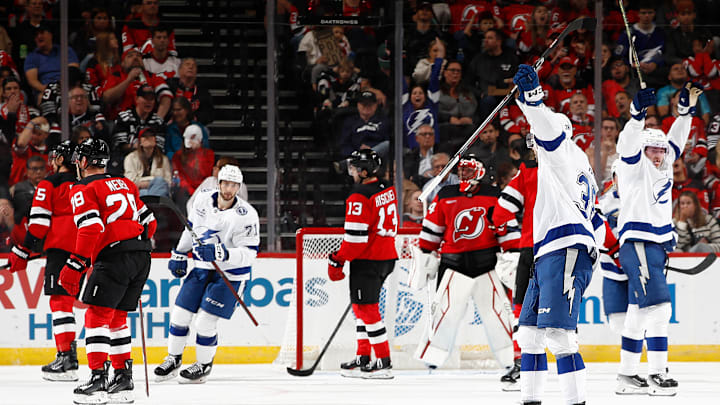The New Jersey Devils faced the Tampa Bay Lightning on Tuesday night, and the end result was an embarrassing 8-5 defeat in front of yet another respectable crowd at the Prudential Center. Every individual with a vested interest in the team and organization was hoping for a healthy and energetic response to what was a disjointed loss to the Washington Capitals on Saturday night. One particular event in the game has been actively discussed among fans online, causing worry and disappointment.
Many fans believe that a major factor in the end result was the Erik Cernak body check on Jesper Bratt and the “lack of response” that followed. While understandable, this opinion is incorrect, and in terms of physicality, Devils fans should not worry going forward.
Part of what makes this season more exciting for the Devils is their healthy combination of skill and grit. Fans are excited because when guys like Jesper Bratt or Jack Hughes get hit, guys like Stefan Noesen, Paul Cotter, Curtis Lazar, Nathan Bastian, Brenden Dillon, or Johnathan Kovacevic will not think twice about responding.
It’s a good thing when a team has some pushback and doesn’t accept being pushed around on a nightly basis. It’s also exciting to hear about a potential line brawl rematch. One in which the Devils will be better prepared for. But, this side of the game was not displayed against the Lightning. Jesper Bratt got caught by Erik Cernak, was body-checked, and sent to the ice, but he was not hurt and finished the game. Ondrej Palat gave a couple of shoves to Cernak after the fact, but from then on, nothing out of the ordinary occurred, much to the fans' chagrin.
Fans of the team were hoping the Devils would get back to their structured plan of action against the Lightning, playing a physical game, being hard on the puck, closing gaps, and cashing in on given chances. These things happened only in spurts Tuesday night, giving the Devils little to no chance in the game. However, their lack of physical response, although a talking point amongst fans, was only part of the problem.
The real problem for New Jersey was its inability to generate and maintain any sort of cohesion in all three zones. They were absolutely star struck by the opposing players and did not do nearly enough to generate any sort of pushback. Their inability to protect the puck in the offensive zone also contributed to the lack of competitiveness in the hockey game.
What gets lost in the excitement of a new season, a new voice, and new faces is the very real process of going from disrepair to repair. Everyone knows the Devils are a team with expectations and potential. They are a team with skill, a competitive level, and some much-needed grit, but what fans need to be reminded of is the transitional process taking place, of going from disrepair to repair, which is part of the journey to contention inherent in every successful franchise.
Case in point: the Tampa Bay Lightning. They have been a staple franchise and the epitome of consistency under Head Coach Jon Cooper for close to a decade and a half. They arrived and dominated a skilled Devils team on their home ice after suffering defeat the previous night. It was a response game from a team that needed a response, and part of that response was a physical brand of hockey.
The Devils are a team that will respond when their backs are against the wall, and they will respond accordingly when their star players get knocked around. But, there was no response against Tampa because they couldn’t respond. They had no response in the defensive zone, had difficulty in the neutral zone, and were caught chasing the game too many times. They legitimately had no response to anything taking place on the ice, which is more concerning than the lack of physical response to a player being hit.
It’s easy to say that Brendan Dillon should go out there and body-check Jake Guentzel, Nikita Kucherov or even Conor Geekie, but it’s an entirely different thing to actually do it. Sheldon Keefe illuminated this aspect of the game in his post-game response to a question about the hit on Bratt. “No, it had nothing to do with the game,” commented Coach Keefe. Coach Keefe’s professional opinion was spot-on. It was simple and concise.
The hit was part of the game, but it was not the reason for the result to have been what it was. The Devils could not keep up with the Tampa Bay Lightning in any facet of the game. To go out there and execute a play is complicated, to go out there and try to hit an opposing is complicated. To go out there and change the momentum of the game is complicated, but the plans are very simple. It’s simple to suggest the Devils should go after players, fight, and body-check everyone in the opposing team's jersey. It’s an entirely different story, however, to execute such a plan.
Unfortunately, losing is part of the repairing process and the 82-game journey that is the regular season. The Devils are now in the midst of a losing streak, their first of the season. They start a back-to-back tonight in Detroit, looking to break this unfortunate streak. A response is necessary; it’s as simple as it is complicated.
